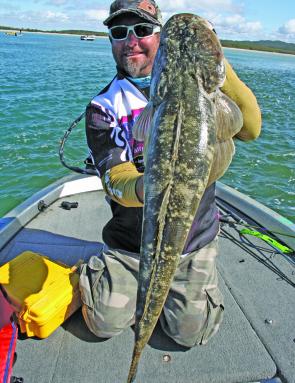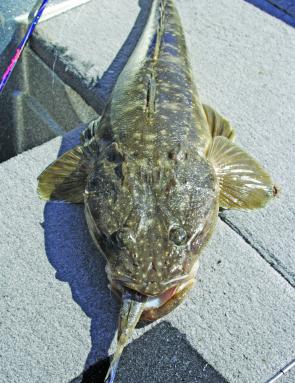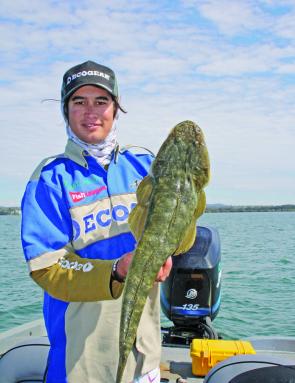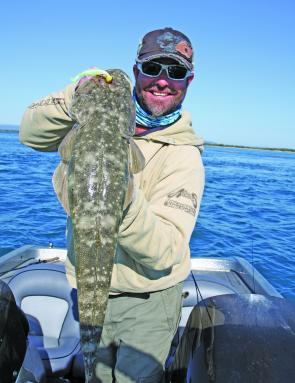The humble flathead was the first fish I can remember catching on a lure as a kid and to this day I get a real buzz when I get the chance to chase big lizards in deep water.
Innovative boat set-ups and fishing tackle now allow anglers to target big flathead in deep water throughout the entire year.
South East Queensland and Northern NSW are blessed with unlimited amounts of accessible deep water where big flathead like to reside. And due to the recent limitations in Queensland regarding catch rates and sizes, the populations of big fish is increasing.
Over the past few years the number of big flathead being caught by anglers has increased, which is mainly due to anglers abiding by the regulations and releasing the big fish to fight another day, which can only make the future stocks of flathead improve.
Flathead like deep water, but targeting the fast flowing deep water ledges where the big fish hold can be daunting. However with a little knowledge and plenty of practice and patience you will be able to catch a big flathead in no time.
Flathead are like most species and will travel around the system chasing the bait. Big flathead can be found in the deep water (30ft+) at any time of the year as long as there is sufficient food in the area. August to November is the prime time to target the big fish, as they gather in larger numbers towards the end of the cooler months and on into summer.
Areas that hold big concentrations of large fish are places that have deep water with good current flow, continually holding good concentrations of food. These areas include the mouth of the Brisbane River, Pumicestone Passage, Jumpinpin Bar, Southport Seaway, Tweed River, Brunswick River, Clarence River and all the creek and smaller river mouths around the southeast.
Not all deep water will hold flathead though. Look for areas that have structure along the bottom that will cause the current flow to eddy and give good access points for the flathead to lay in ambush. Logs, pipes, rocks and mud clumps will be the areas to target rather then just targeting the sandy or muddy bottoms.
I’ve found over the years from viewing them when diving that flathead love a bit of structure and will lay adjacent or on top of the available structure. I’ve also seen many big congregations of massive fish within very small areas so finding them and continually working the same areas usually results in regular captures. Once you find a good fish holding area you can usually return different times of the year and catch the big ones.
Lure choice is virtually endless these days with many companies supplying countless choices. I use the Ecogear range of soft plastics and big vibration baits but it’s more to do with size and action rather than the brand of lure that catches big fish.
For big fish I like the Ecogear VT 20 and 30, which are larger 100mm, 20g and 30g vibration baits with a very strong rattle that annoys the hell out of flathead. I also carry a variety of 4”, 5” and 6” single tails, T-tails and minnows. A good starting point for big flathead would be a lure around the 100mm, from there you can experiment. I’ve used 300mm plastic worms and caught quality fish but 100-150mm the preferred size for most anglers.
The amount of weight the lure or jighead will need to reach the depths where the big fish are holding will depend on the current flow. You need to use enough weight to easily keep your offering on the bottom but you don’t want to use too much weight that it keeps snagging in the structure. A selection of vibration baits and jigheads from 1/2oz to 1oz will suffice for most location and current flows.
Colour is something that every angler will debate over; some like pink other anglers, where others will swear by chartreuse but I feel it’s far more important to put the lure in front of the flathead’s mouth than a particular colour. As the saying goes – flathead will just about eat anything that moves in front of them.
I tend to use bright colours like oranges and chartreuses in the deep water but at times I use very natural looking bait fish style colours. It all depends on the mood of the big fish; some days they like bright, in-your-face colours and other days natural colours work best. Just experiment with vibration and colour each day you target them. You will find over time that you will have your favourites that continually work and you will sick to those colours and vibrations.
Flathead ambush prey by lying on the bottom, camouflaged into the environment. They will feed on the surface and in mid water, but when chasing deep water flatties you need to keep you lure offering as close to the bottom as possible.
When fishing with lures I like to treat every species as if they are inactive or shut down and place my offering as close to the fish as possible. Flathead will often be very active and move long distances to smash your offering but if you treat them as inactive you will catch lots more fish and cover more areas.
The basic retrieve I use for both vibration and soft plastic lures is a lift and hop retrieve. I only lift the lure about 6” to 1ft off the bottom with every lift and then settle the lure back on the bottom creating a sediment plume which attracts the flatheads attention. I mix up my retrieves by alternating between one, two and three hops at a time but even if I do a three hop sequence I still only lift it about 1ft; each hop totals about 10cm.
Allow your preferred offering to sink where you cast your lure. So many times I see anglers cast their lure and instantly engage their reel and the lure (with depth and current flow) just pendulums back towards the boat only contacting the bottom for a short period before they wind their lure in and recast.
It’s best to cast the lure upstream of your boat and allow it to settle on the bottom and then commence your retrieve pattern. By drifting at the same speed as the current and keeping your lure on the bottom at all times, you will continually encounter the big fish. One you’ve found areas where big fish hold you can leave your lure on the bottom and using the same ‘lift and hop’ technique, vertically jig.
Some anglers like to do big ‘lift and hops’ but I’ve found keeping my bait as close to the bottom as possible allows me to cover the bottom structure better and my lure doesn’t get affected by strong currents as much.
When drifting deep water ledges you will have to continually let more line out from your reel to stay in contact with the bottom but that’s deep water fishing. You can go to a heavier jig or vibration bait but I find that the lighter lure/jig you use the more fish you will catch.
This is the same technique I use for most deep water situations whether I’m fishing for barra in north Queensland or threadies in the Brisbane; small lifts and hops and staying in contact with the bottom will produce big fish.
Positioning your boat correctly is paramount to successfully keeping you offering in the strike zone for a prolonged period. By fishing parallel to the bank you are targeting a wider area instead of just sitting at 90º and casting at the bank, your success will improve.
Often the big fish sit hard against any ledge or structure on the bottom, which can be where the rocks meet the sand along a retaining wall or where any ledge meets the bottom. Fishing parallel to the drop-off or ledge will always keep your bait in the strike zone.
Big flathead have a very distinctive bite that you will feel when then they engulf your preferred offering. It’s a definite clunk on your line, the big fish hold onto the lure, giving you enough time to really set the hooks hard and begin your battle.
Once you’ve caught a few big flathead the fight will become very familiar. Big fish like to battle it out close to the bottom, taking short runs with big head shakes until they tire and start the slow battle back to the boat. Most big fish will let you see them and then take that last dive for freedom before swimming peacefully into the net. They then tend to go crazy for a minute before relaxing and allowing you to do the duties of releasing them.
Rod and reel choice is entirely up to you. I tend to always use baitcasters over spin outfits due to the size of the flathead and the other species you will encounter using these techniques. I use light 2-4kg rods with 9kg Yamatoyo PE with 20-30lb leaders depending on the structure.
There is no better feeling than seeing a big flathead ascend from the clear depths and then getting the chance to release the big girl to fight another day. Big flathead stocks will continue to improve and with a little practice and patience you too will be landing some monsters soon.
Facts
Careful handling
It is inevitable when fishing the deep water that you will come across an oversized fish. In Queensland fish over 75cm are protected by law and must be returned to the water as soon as possible. This means you will need to be able to release your fish quickly and efficiently.
Some tips include using a knotless landing net, having a wet towel and measuring mat on hand and ready, as well as a protective glove and a pair of pliers. These tools will allow you to process the fish quickly with minimal handling time and let the big girl go.
Don’t forget the camera for a memory shot, but seriously think about getting a shot of the fish in the water as it swims away.

Remember flathead have a legal limit of 75cm, so they must be released over this length.

Big lures catch big flatties.

Ensure you support the weight of the big girls so they can be released unharmed.

Flathead fight seriously hard when they get to this size.




